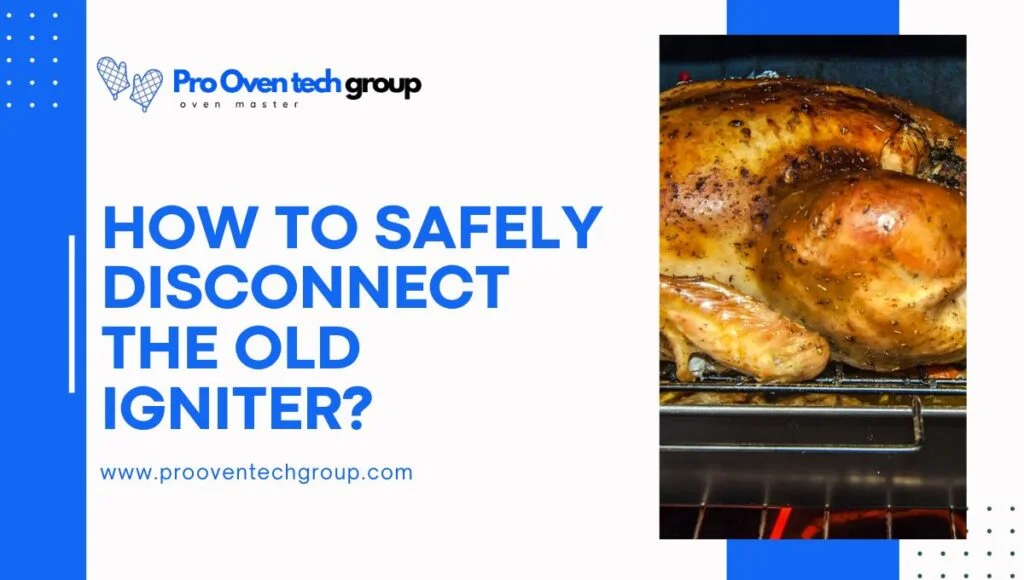How to replace a gas oven igniter? Ready to learn how you can replace a gas oven igniter yourself? We’ve got you covered! Whether you’re a homeowner looking for simple DIY projects, or an apartment renter who needs to save on costly appliance repairs, our step-by-step guide will show you all the tools and tips needed to get your project done efficiently and safely.
To replace a gas oven igniter, first, ensure the oven is unplugged and gas supply is turned off to prevent accidents. Next, remove the oven racks and oven bottom to expose the igniter.
In this post, we’ll take everything from essential safety precautions to helpful diagnosis methods in order to ensure that your gas oven remains functional and reliable. With this valuable information, anybody can tackle their own appliance repair success story – it’s time for the workbench!
Table of Contents
What type of igniter do you need for your oven model?
Firstly, it’s crucial to identify the type of igniter your gas oven model needs. There are two main types of oven igniters – ‘hot surface’ and ‘spark’. Hot surface igniters, typically made from silicon carbide or silicon nitride, glow bright orange to light the gas burner.
Secondly, ensure that the igniter you choose for replacement is compatible with your oven model. The igniter must fit properly in the igniter bracket and connect seamlessly with the wiring harness. The specifications can be found in the appliance manual or on the label inside the oven door.
Lastly, consider the longevity and performance of the igniter. Always opt for high-quality igniters that can withstand high temperatures and prolonged use. Cheap replacements may seem appealing initially but could cost more in the long run due to frequent replacements.
How to safely disconnect the old igniter?

Before starting the actual replacement process, it’s imperative to disconnect the old igniter safely. This crucial step involves handling electrical wires and connectors, so extra caution is a must. In this section, we will walk you through the necessary steps to disconnect the old igniter without harming yourself or damaging your oven.
Identify and Disconnect the Wire Connectors
Locate the wire connectors that attach the igniter to the oven. These are typically encased in a plastic insulator. Carefully disconnect these connectors by pulling them apart. Never tug on the wires themselves as this can lead to damage.
Remove the Igniter Bracket
The igniter is held in place by a bracket, which is secured with screws. Use a screwdriver to remove these screws. Keep them safely as you’ll need them to install the new igniter. Ensure you support the igniter as you unscrew the bracket to prevent it from falling.
Detach the Old Igniter
With the bracket screws removed, gently slide out the old igniter. Be cautious not to pull or jerk the igniter as this could damage the gas tube that it’s attached to. Handle the old igniter carefully as it may be hot or fragile due to wear.
How to test and install the new igniter?
Before you install the new igniter, it’s important to test its functionality to ensure it works properly. A defective igniter can result in gas leaks or oven malfunctioning, so taking a few extra minutes to test the new part is crucial.
- Prepare the New Igniter: Remove the new igniter from its packaging. Handle it carefully to prevent any damage.
- Locate the Wire Connectors: Connect the new igniter to the oven using the wire connectors. Ensure the connectors are firmly attached.
- Test the Igniter: With the igniter connected, briefly turn on the oven. The igniter should glow bright orange or emit a spark, depending on the type of igniter.
- Turn Off the Oven: Immediately turn off the oven after the test. Disconnect the igniter from the oven.
- Compare the Old and New Igniters: Ensure the new igniter matches the old one in size, shape, and connector type. This will guarantee a seamless fitting.
- Check the Igniter Bracket: Make sure the igniter bracket fits correctly with the new igniter.
- Inspect the Igniter Wiring: Check the igniter wiring for any signs of wear, damage, or burning. If any of these signs are present, consider replacing the wiring before installing the new igniter.
Tips on troubleshooting a faulty gas oven
Gas ovens can exhibit various symptoms that indicate a faulty igniter or other issues. Learning to identify these signs can help you diagnose the problem and apply the appropriate solution.
- Uneven Baking: If your food is often undercooked or burned, this could signify an igniter that’s not heating to the correct temperature.
- Delayed Ignition: A delay in the oven’s ignition can point to a faulty igniter.
- Gas Smell: This could be a serious sign of unignited gas leaking from a malfunctioning igniter.
- Loud Bangs: Hear a bang when you turn on the oven? The igniter may be allowing gas to build up before ignition, causing a small explosion.
- No Heat: If your oven isn’t heating, the igniter might be the culprit. Check to see if it’s glowing; if not, replacement may be necessary.
Recommended tools for the job
Installing the new oven igniter is a straightforward process when done correctly and carefully. Here are the key steps to follow:
- Secure the New Igniter: Attach the new igniter to the gas tube using its bracket and the screws you saved from the old igniter.
- Reconnect the Wire Connectors: Connect the new igniter to the oven wiring. Make sure the connectors are secure.
- Replace the Oven Components: Once the new igniter is installed, replace the oven bottom and racks.
- Test the Oven: Turn the oven on to ensure the new igniter is functioning properly.
- Monitor Oven Performance: Over the next few uses, watch for any signs of irregular oven functionality.
Is it better to call a professional or DIY it yourself?

There’s always a debate between tackling a project DIY style or hiring a professional. Your decision depends on factors such as your comfort level with appliances, available time, and cost considerations.
- Technical Expertise: Professionals have technical knowledge and experience, ensuring the job is done right the first time.
- Safety: Professionals are trained to handle potential hazards, reducing risks associated with DIY repairs.
- Warranty: Many professionals offer a warranty on their work, providing peace of mind.
- Time-efficient: Professionals can usually complete jobs quicker, saving you time.
- Cost-effective in the Long Run: Professionals can identify and fix other potential issues during their visit, reducing the likelihood of future costly repairs.
Conclusion How to replace a gas oven igniter
In the end, replacing a gas oven igniter is not rocket science, but it does require some technical knowledge and caution. With the right tools and steps, you can successfully DIY this project and save on costly repairs. However, if you’re uncomfortable or unsure of your skills, it’s always safer to hire a professional to ensure proper installation and avoid potential hazards. Remember to always test the new igniter before and after installation to ensure it’s functioning correctly. And don’t forget, safety should always be a top priority when working with gas appliances.
FAQS
Q1. how to replace oven igniter (whirlpool)?
A1. To replace the oven igniter on a Whirlpool oven, follow these steps:
1. Turn off the gas supply and unplug the oven.
2. Remove the bottom panel and racks from the oven.
3. Disconnect the old igniter’s wire connectors and remove its bracket screws to detach it from the gas tube.
4. Prepare and test the new igniter before installation.
5. Secure the new igniter to the gas tube using its bracket and screws.
6. Reconnect the wire connectors and replace the bottom panel and racks.
7. Test the oven to ensure proper functionality.
Q2. How to replace igniter on gas stove?
A2. Replacing the igniter on a gas stove may vary depending on the model, but generally involves these steps:
1. Unplug the stove and turn off the gas supply.
2. Remove the burner grates, caps, and bowls from the top of the stove.
3. Lift up and remove the cooktop to access the burner assembly.
4. Disconnect the old igniter’s wire connectors and unscrew any mounting brackets or screws.
5. Install the new igniter using its bracket and screws, then reconnect the wire connectors.
6. Reassemble the stove and test it for proper function.
Q4. Are all gas oven igniters the same?
A4. No, gas oven igniters can vary in size, shape, and connector type depending on the brand and model of the oven. It’s important to purchase the correct replacement igniter for your specific oven. So, it’s recommended to check your oven’s manual or consult a professional for assistance in finding the right igniter for your appliance.
Q5. How long do gas oven igniters last?
A5. The lifespan of a gas oven igniter can vary depending on usage and maintenance, but generally it can last anywhere from 3-5 years. Regular cleaning and avoiding harsh chemicals near the igniter can help prolong its life. Additionally, purchasing a high-quality igniter may also increase its longevity. If you notice any signs of malfunctioning or damage, it’s best to replace the igniter as soon as possible.

